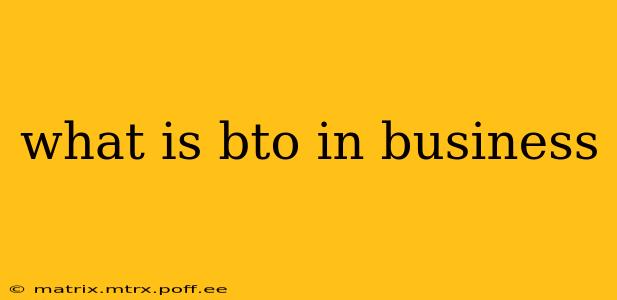In the dynamic world of business, understanding acronyms is key to navigating industry conversations and strategies. One such acronym, frequently encountered in manufacturing and supply chain management, is BTO, which stands for Build-to-Order. But what exactly does it mean? This comprehensive guide delves into the intricacies of BTO, explaining its implications, benefits, and drawbacks.
What Does Build-to-Order Mean?
Build-to-Order (BTO) is a manufacturing process where products are only produced after receiving a customer order. Unlike mass production, where items are manufactured in advance and stocked in anticipation of demand, BTO involves tailoring production to specific customer requirements. This means that the manufacturing process only begins once an order is confirmed, leading to customized products tailored to individual preferences or unique specifications.
This approach contrasts significantly with other manufacturing methods like Build-to-Stock (BTS), which involves producing goods in advance based on demand forecasts, and Engineer-to-Order (ETO), which involves designing and manufacturing products according to highly specific customer requirements that may need significant engineering. BTO sits somewhere in between, offering customization without the extreme lead times often associated with ETO.
Benefits of Implementing a Build-to-Order Strategy
The BTO model presents several compelling advantages for businesses:
-
Reduced Inventory Costs: By only producing goods when ordered, businesses drastically reduce storage costs, warehousing expenses, and the risk of obsolescence. This frees up capital for other strategic initiatives.
-
Increased Profit Margins: The absence of large inventory holding costs often translates into higher profit margins per product.
-
Higher Customer Satisfaction: The ability to customize products leads to greater customer satisfaction as customers receive exactly what they want. This tailored approach fosters loyalty and positive word-of-mouth marketing.
-
Improved Efficiency: While it might seem counterintuitive, BTO can lead to improved efficiency by streamlining production processes focused on specific orders rather than mass production. This focus reduces waste and streamlines operations.
-
Lower Risk of Unsold Inventory: The inherent risk of producing unsold inventory, a common issue with BTS, is virtually eliminated in a BTO system.
Drawbacks of a Build-to-Order System
While the benefits are numerous, BTO also presents some challenges:
-
Longer Lead Times: Customers must wait longer to receive their products compared to BTS. This can be a significant drawback for customers who need items quickly.
-
Increased Demand for Efficient Order Processing: A robust order processing system and efficient supply chain management are crucial for successful BTO implementation to prevent delays.
-
Potential for Supply Chain Disruptions: Any disruptions in the supply chain can significantly impact the production timeline and lead to delays.
-
Higher Complexity in Production Planning: Managing orders and coordinating production resources can be more complex in a BTO system.
-
Less Predictable Revenue Streams: Revenue forecasting can be more challenging compared to BTS due to the variable nature of orders.
How to Determine if BTO is Right for Your Business
The suitability of BTO depends significantly on several factors:
-
Product Characteristics: BTO is particularly well-suited for products that allow for some degree of customization without extensive engineering changes. Complex products with unique specifications might be better suited to ETO.
-
Customer Demand: Predictable and consistent customer demand is crucial for effective BTO implementation. Highly volatile demand patterns can lead to production inefficiencies.
-
Production Capacity: Businesses must possess sufficient production capacity to meet customer orders without excessive delays.
-
Supply Chain Capabilities: A reliable and efficient supply chain is paramount to ensure timely procurement of materials and components.
What are the differences between BTO, BTS, and ETO?
This is a frequently asked question, and the differences are crucial to understand. As mentioned previously, Build-to-Stock (BTS) involves producing goods in anticipation of demand, leading to quicker delivery but higher inventory costs and risk of unsold stock. Engineer-to-Order (ETO) focuses on highly customized products that often require significant design and engineering before production commences, leading to longer lead times but highly bespoke solutions. BTO sits between these two, offering a balance between customization and lead time.
What are some examples of BTO businesses?
Many businesses utilize BTO successfully. Examples include companies offering personalized computers, custom-designed furniture, bespoke clothing, or specialty vehicles. Essentially, any business offering a product where customization is a key selling point or where demand is relatively predictable is a strong candidate for a BTO strategy.
Implementing a Build-to-Order system requires careful planning and consideration of various factors. By understanding its advantages and disadvantages, businesses can determine if BTO aligns with their overall business objectives and customer needs. Careful assessment and strategic implementation can lead to significant improvements in efficiency, profitability, and customer satisfaction.
